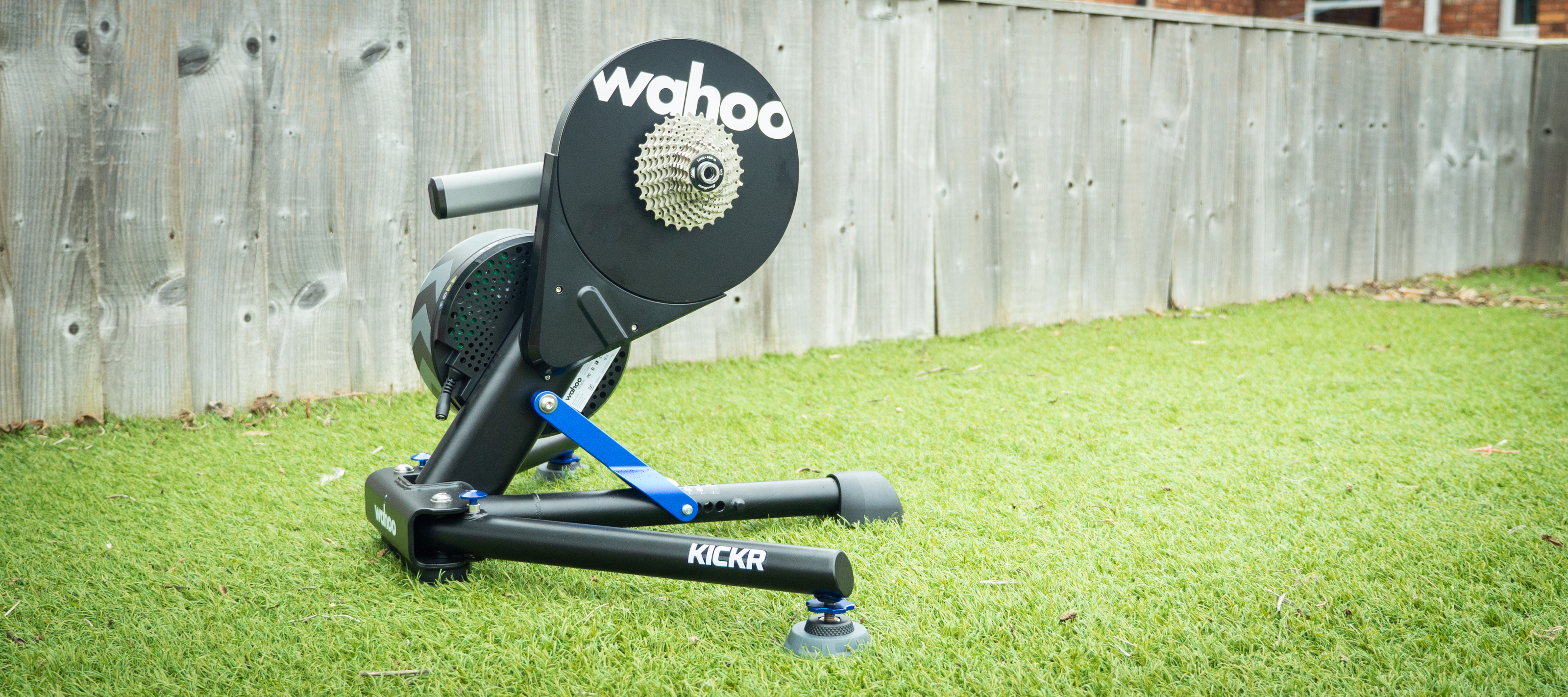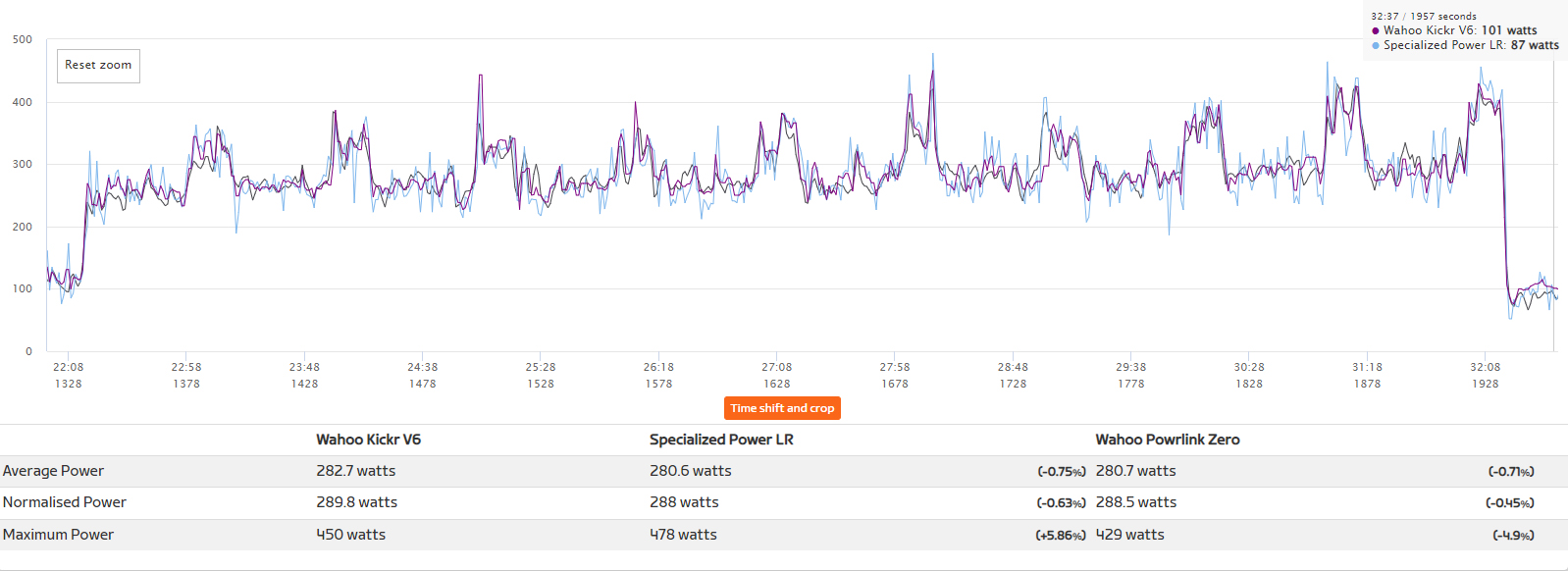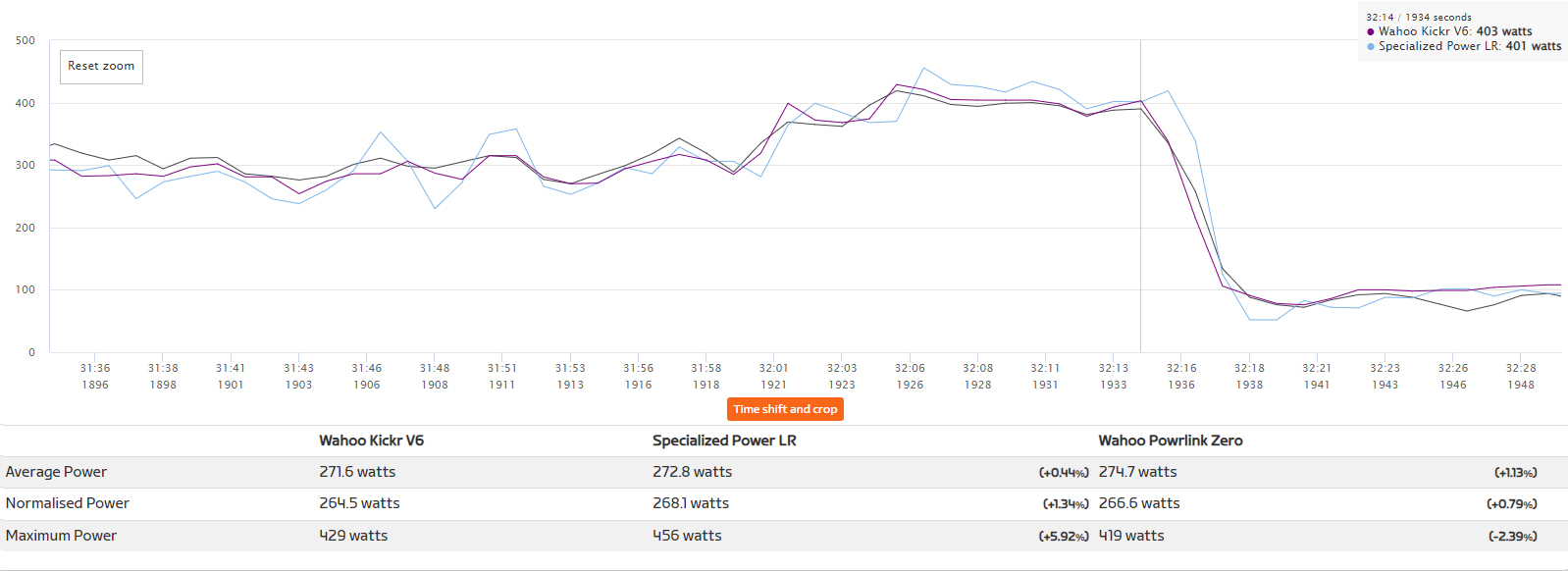Cyclingnews Verdict
There's no doubt the Wahoo Kickr V6 is more well-rounded than its predecessor and among the best smart trainers on the market. WiFi connectivity is a good addition, but the V5 might be a better choice for some people.
Pros
- +
Wahoo's famously simple setup process
- +
Top-line specs including 2200w resistance, 20% gradients and 1% accuracy
- +
The addition of WiFi connectivity
- +
Automatic firmware updates
- +
'Erg Easy-ramp' eases you back to high power if you need to stop
Cons
- -
WiFi connection requires stable WiFi, which isn't always a given
- -
The price is higher than the previous model
You can trust Cyclingnews
For 10 years, the Wahoo Kickr smart trainer has been one of the leading weapons in the war against riding outdoors. Ok, perhaps it's not quite a war, but thanks to the technological advances pioneered by brands like Wahoo, the experience of indoor cycling has improved infinitely, and the number of people pedalling nowhere indoors has grown at a stratospheric rate.
There's no denying the indoor cycling industry is moving at a fast pace but if product cycles are anything to go by, none are moving faster than Wahoo, whose 2022 Kickr smart trainer was the third new model to launch in five years. This is technically known as Kickr V6 2022, and replaces the V5 which launched in 2020.
Its launch celebrated the 10th anniversary of the original Kickr, and while the five subsequent iterations have seen advancements come thick and fast to keep them competitive among the best smart trainers, their DNA has remained largely unchanged. This includes two round metal legs, which fold out from a third central leg to form a trident base. Above the base, a belt connects the flywheel and the drive wheel, onto which an 11-28 Shimano-compatible SunRace cassette comes fitted. The black, grey and blue theme has been a constant, and Wahoo's famously simple app-based setup complements the easy-to-setup hardware nicely.
When compared to the 2020 model, the Kickr 2022 is more of the same. Aesthetically it is almost identical, but a few features have been added internally. One of those could bring huge benefits down the line, according to Wahoo.
Design & Specifications
I'll start with what remains the same with Kickr 2020, and to prove the above claim that the two models are aesthetically similar, let's play a game of spot the difference.

As you can see in the images above, there's very little difference. It appears in the images that the handle of the new Kickr is angled differently, but that's because I hadn't yet adjusted the wheel height to the higher 700c setting.
In reality, apart from a status light on the rear which I'll discuss in more depth later, there's nothing to distinguish the two.
The latest race content, interviews, features, reviews and expert buying guides, direct to your inbox!
Functionally, it remains largely the same too. The three legs, the ergonomic carry handle introduced in 2016, the adjustable height for different wheel sizes, and the black-blue-grey colour theme are all still present, as are the Axis feet introduced in 2020.
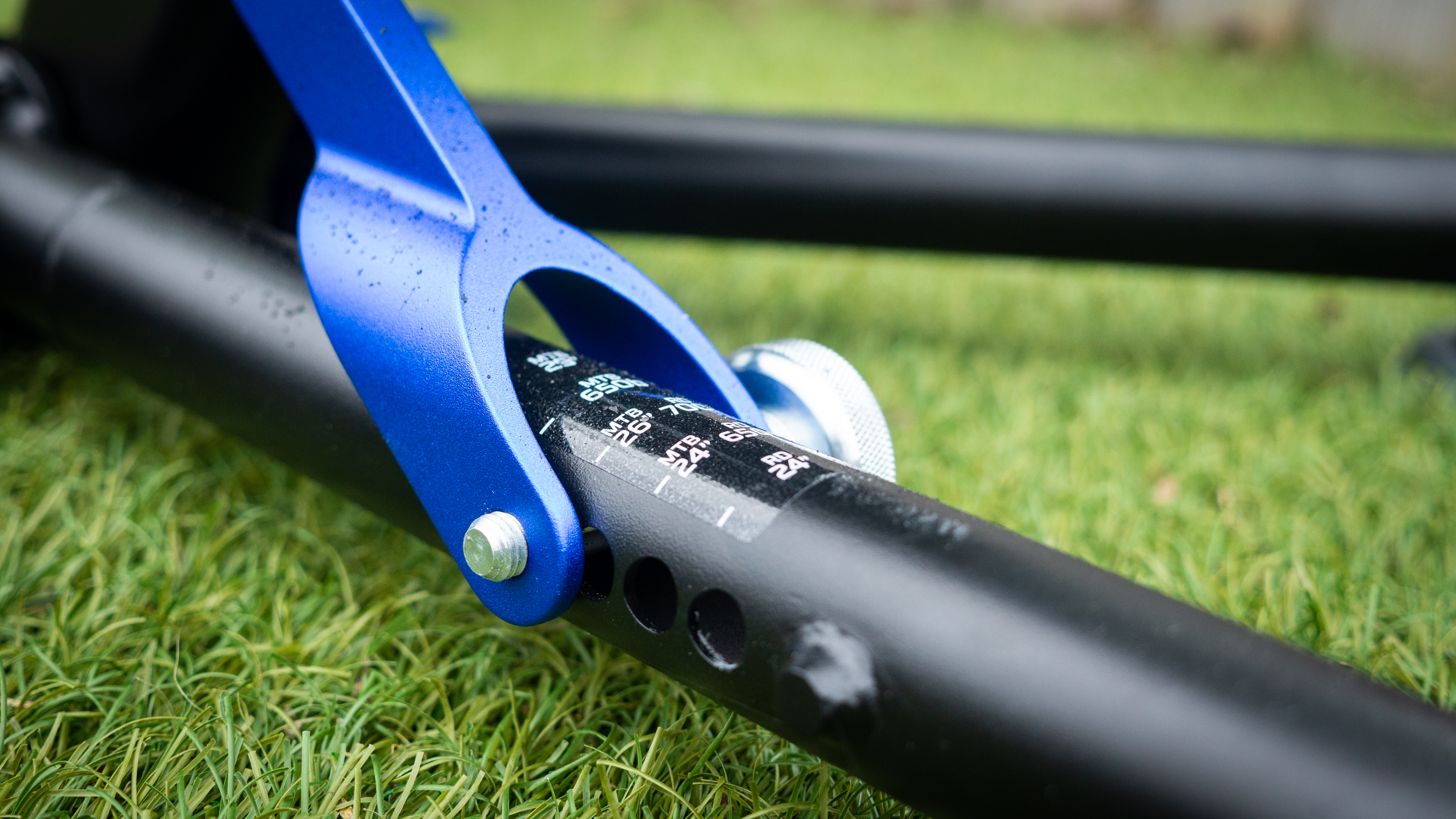
Internally, the top line specs remain the same too. This includes a maximum resistance capability of 2200 watts, gradient simulation of up to 20%, and power measurement accuracy within +/- 1%.
Comparatively, that makes the Wahoo Kickr the joint most accurate on the market alongside the Tacx NEO 2T, the Elite Justo, and the Saris H4. The Tacx Neo 2T and Elite Justo boast the greatest maximum resistance, but we're at the point where this number is almost irrelevant, as it exceeds what almost all of us can put out.
The gradient simulation is slightly more relevant, especially for those wanting to replicate real-world routes. The 20% gradient is bested by Tacx and Elite again, but the Kickr is the only model available with Wahoo's Kickr Climb, which raises the front of the bike. Elite has the Rizer, which does a similar thing.
There's still a 7.25kg (16lb) flywheel, and as before the Kickr 2022 will automatically calibrate itself whenever you freewheel. It also comes with the same adaptors for the various axle standards available on the market today, including 12x142mm and 12x148mm thru-axles, as well as 130mm and 135mm quick-release.
Elsewhere, despite the shift towards 12-speed now being pushed by all three of the major groupset brands, Wahoo believes its customers still predominantly use 11-speed groupsets on their indoor trainers, and as such, the Kickr 2022 comes fitted with the same 11-speed 11-28 SunRace cassettes as the previous model.
On that subject, a Wahoo spokesperson has confirmed to Cyclingnews that it will be looking to add an option to choose your cassette as part of the checkout process in the not-too-distant future.
Now it's time to look at what's new with Kickr V6 2022, and I've broken that down into those respective features.
WiFi:
This is the biggest change from the previous Kickr. Put simply, it connects your Kickr directly to your home's WiFi network, allowing it to communicate with your devices via an internet connection, rather than relying on Bluetooth or ANT+.
Wahoo claims "this helps solve most drop-out issues and delivers your on-screen stats over 65% faster than before."
The WiFi builds on the 'Direct Connect' technology introduced with the 2020 Kickr, which added an ethernet port to the rear of the trainer and allowed users to directly connect their trainer to their WiFi router or laptop using the aftermarket Wahoo Kickr Direct Connect adaptor. That adaptor retails for £79.99 / $99.99, which isn't insignificant. The new Kickr still features the ethernet port and can still connect directly to your router or your laptop, but it's no longer needed thanks to the WiFi.
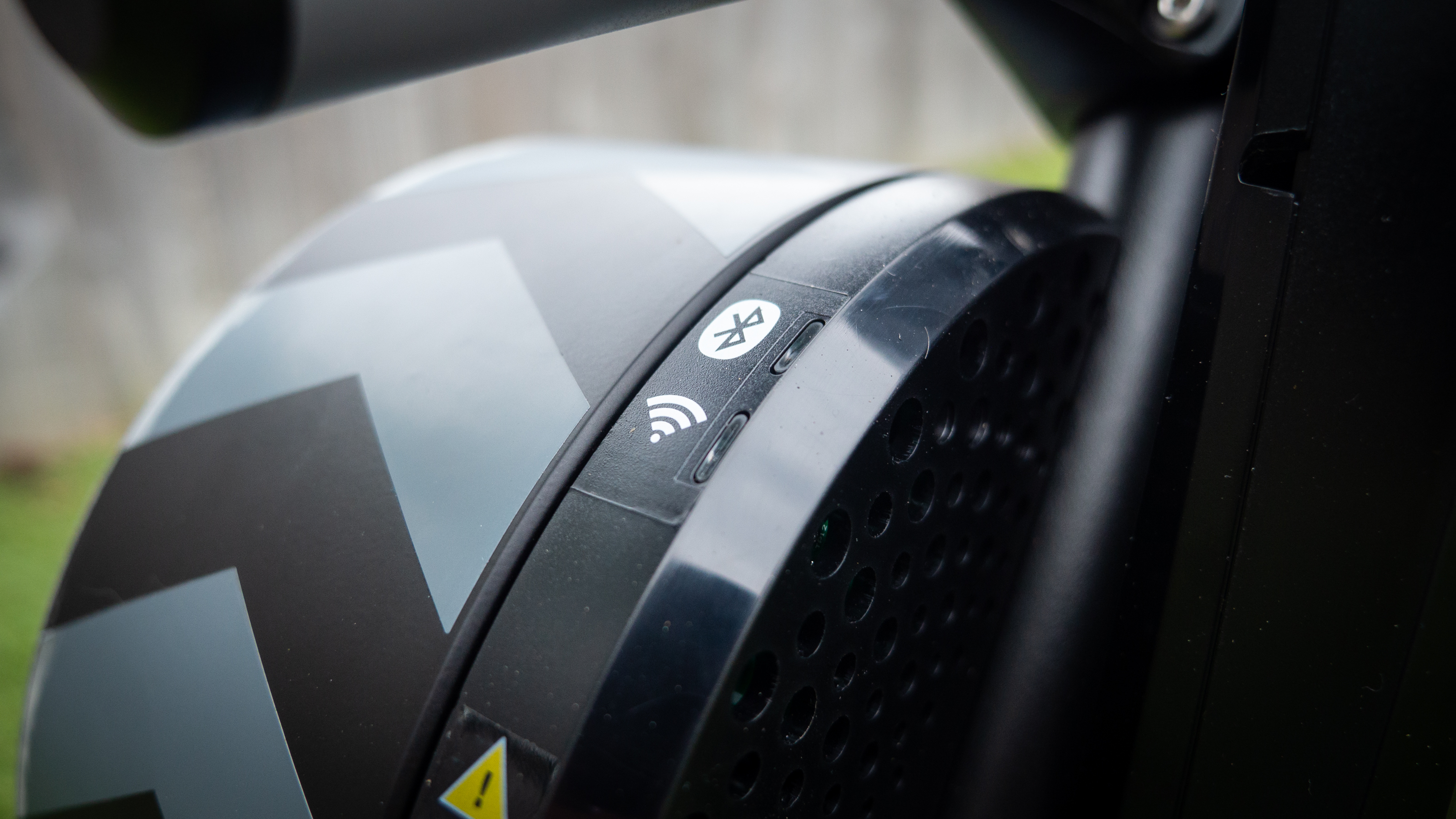
Accompanying the addition of WiFi is the only aesthetic difference between the 2020 model and the Kickr 2022; a new status light on the rear of the trainer. Whereas the previous model had status lights for Bluetooth and ANT+, the latter has now been replaced with WiFi status instead.
Throughout my review of the Kickr 2020, one of the downsides I found wasn't necessarily with the Kickr itself, but the connectivity between my Kickr and my Bluetooth-enabled laptop. I don't know specifically what was causing the issue, but on occasional rides, my connection to the trainer would repeatedly drop and reconnect. I put it down to Bluetooth interference, especially since I'm regularly running multiple power meters, heart rate monitors, headphones and more. The dropout was never so vast that it caused my ride to stop, but it would cause low-reading average power numbers, and occasionally mean that resistance would remain 'stuck' at the higher power after an interval was finished. The inclusion of WiFi is a potential solution to this problem, and could also benefit those who live in areas where Bluetooth interference is more likely, such as apartment blocks.
In terms of which apps can take advantage of WiFi, Wahoo tells us that "all apps that added Direct Connect support are able to connect and control the Kickr over WiFi out of the gate. This includes Zwift, Fulgaz, TrainerRoad, RGT and Systm (Windows and Mac) with more apps slated to add support later this fall."
The introduction of WiFi also means the Kickr will automatically update its own firmware, rather than the current process of opening the Wahoo app to check for them. If you're anything like me, you'll do all your indoor training via other apps and can go months without needing to open the Wahoo app at all, thus meaning firmware updates can easily be missed. This solves that issue, meaning bug fixes, feature add-ons, and any performance improvements (for the trainer, sadly not the rider) will just happen.
The third benefit of the WiFi is a direct connection to Wahoo's customer support for diagnostics. If you have issues with your trainer, Wahoo will be able to run certain tests remotely, potentially even resolving problems from afar. Wahoo tells us that there are even more benefits to come from WiFi connectivity down the line, but refuses to give any clues as to what they might be.
ERG Easy Ramp
ERG technically stands for ergonomic resistance, but it's best described as 'letting the trainer handle the resistance'. Power is calculated as torque (how hard you're pressing the pedals) multiplied by cadence (how quickly you're spinning them). Given your workout knows how much power you should be doing in each interval and what your cadence is at any given time, it can reverse calculate for torque. It performs this calculation multiple times per second and adjusts the resistance accordingly.
This isn't in any way new, or even specific to the Kickr, but anyone who's stopped halfway through a hard interval will know that it requires enormous torque to get going again. Your cadence starts at zero, so many turbo trainers simply heap on maximum resistance as required by that backwards calculation, and it can require a leg-sapping standing start to overcome. ERG Easy Ramp solves this with a 10-second period of ramped resistance, allowing you to bring your cadence up before the trainer restarts the desired workout. I put this to the test by stopping mid-interval on a few occasions and it works exactly as described. Of course, it's only relevant when you stop mid-interval, meaning it only shows itself on those infrequent occasions.
Odometer
A small third change is the introduction of an odometer. Wahoo says that this "identifies the exact amount of use, helping you to keep track of progress by knowing how many miles you've achieved," but I expect this will be more commonly used as part of the aforementioned remote diagnostics feature, so Wahoo can tell how much use a trainer has been through. It could also be beneficial for those looking to sell their trainer down the line.
Price
The final change was a less welcome one. With the added development and ever-increasing costs, Kickr 2022 saw a price hike to £1099.99 / $1299.99 / €1299.99.
Performance
Starting with the initial setup, much remains the same as the previous Kickr, which as one of the most straightforward out there, is no bad thing.
You'll need to download the Wahoo app, and once you've created an account, you can follow one of two walkthroughs. Either 'quickly pair a new sensor', or follow the 'setup wizard' for a more in-depth process. It's worth going through the latter, as it walks you through the process step by step.
A recent addition to this process includes a thorough look into the basics; choosing the correct Axis feet, folding out the legs, choosing your required adaptor, etc. It appears that like Zwift with its new Zwift Hub trainer, Wahoo has also realised that the setup process can be a daunting one for beginners, and sought to simplify it.
Part of the process is to connect your device to WiFi, and from this point on, it's a simple case of choosing one of the many available indoor cycling apps. Wahoo owns Systm and RGT, but I also spend time using Zwift and TrainerRoad, and the connection was pretty straightforward. For anyone who's not used the Direct Connect, it comes up as a separate option in the list of found devices, as shown below.



Power accuracy
For all of my accuracy tests, I compared the Kickr to the S-Works Power LR power meter and a pair of Wahoo Speedplay Powrlink pedals.
The first of my rides on the new Kickr was a 45-minute ride with some threshold over-unders, connected via Bluetooth. This allowed me to get a feel for how quick the pickup of resistance was in response to the suggested workout, and how quickly it dropped back down, while double-checking that the Bluetooth connectivity was as good as the previous model. Ultimately, the workout was drama-free, with accurate power and response times as quick as expected. There was no difference to the previous model, which is no bad thing.
Unfortunately, the Speedplay pedals were reading around 20 watts low throughout so I've excluded those from the graph.
The second of my rides included 3 x 5 minutes at Vo2 Max, allowing me to test the steadiness of the power reading at both high power (relative - I concede that my power numbers aren't breaking any records) and low power, as well as how quickly the Kickr brought me back to target power whenever I went above or below it.
This was also connected via Bluetooth, and once again, everything appears to be working exactly as it should.
The third test was connected via WiFi. My usual turbo trainer setup is in my garage, which is situated right on the edge of my WiFi's reach. As such, it feels like my setup will prove a good real-world test for Wahoo's claims of improved stability.
In terms of power measurement and speed of the Kickr's response to workout changes, everything worked exactly as it should.
Connectivity
There is one thing to note with my final workout above. Halfway through, my WiFi dropped out. Of course, this isn't the Kickr's fault - I set my trainer up in the garage, which is right at the limit of my WiFi router's reach, and dropouts are pretty common.
Usually, if this were to happen when connected via Bluetooth, all that would happen is whatever I'm watching on my laptop would pause. Zwift would also pause, were I using it, but I tend to do my structured workouts via TrainerRoad to avoid this. This time around, due to the WiFi connection between my trainer and my laptop, it disconnected the turbo trainer and stopped my workout for a few minutes.
This isn't an isolated incident, either. I've experienced it numerous times, to the point that I've reverted to using Bluetooth as my first choice. Luckily, the 2022 Kickr's Bluetooth connection is just as reliable (and less obtrusive when issues do occur) as its predecessors, which I've used extensively with plenty of success.
At the moment, there's no ability to 'double up' your connection, ie having one as the primary connection and the other as a fall-back, but I would like to see it added. Overall though, if your setup is similar to mine in that WiFi stability isn't a given, then the introduction of WiFi connectivity might not be all that useful from a day-to-day riding perspective.
Of course, if your Zwift setup is in your living room six feet away from your router, then it's likely a different story. To test this, I brought the trainer into the house, closer to my router, for a week. During this time, I experienced no issues, which furthers my belief that this is a good feature for most people.
Also, there's nothing stopping me from continuing to connect via Bluetooth, and using WiFi only for its other benefits (firmware updates, diagnostics). Zwift also promised 'future' features, but a year on we're yet to see what those will be.
Other added features
Most smart trainers perform in a similar way, they have similar specifications and offer much the same functionality. Wahoo is doing things differently with the introduction of WiFi, but it's often in the added features that you find differences from brand to brand.
In the case of Wahoo, the most obvious of these is the Axis feet. These come as standard on the Kickr 2022 and the Kickr 2020, and offer five degrees of side-to-side movement, offering a little added realism to the ride, while also reducing the stresses applied to both you and your bike. Tacx offers aftermarket Neo Motion Plates that offer a similar function, while the Elite Justo comes with 'Flex' feet. Ultimately, the difference isn't enough on its own to warrant an upgrade from the feet on the Kickr 2018, but this system is becoming the norm on top end trainers.
Elsewhere, the Kickr offers automatic calibration. This was fairly groundbreaking when Wahoo announced it in 2020, but since then, others have followed suit and even the budget Zwift Hub is set to introduce this feature soon. It's certainly a good feature to have, and in my experience with both this Kickr and the predecessor, it's been seamless.
The automatic firmware update is another that has become seamless. In my few months of testing, I don't know how many firmware updates there have been, and that's exactly how I want it to remain. We're all too busy to care about firmware updates, and we're certainly too busy to spend 10 minutes before a workout watching it update. To have it automated is a great addition.
Verdict
Overall, the Wahoo Kickr V6 2022 takes the already-excellent Kickr trainer platform and improves it in a few ways. The most pertinent of those is the introduction of WiFi connectivity, which has the potential to improve the stability and speed of your connection while allowing for automatic updates and remote diagnostics. Depending on the device you're using and the WiFi stability in your home, that could either be a complete game-changer or actually make things worse. However, those who experience the latter can still revert to Bluetooth for day-to-day riding while still benefitting from automatic firmware updates.
In my opinion, the Kickr 2022 doesn't represent enough of a step up to warrant an upgrade from V5, so if you're already running that, don't rush out to buy a new one today.
If you can find one and it's discounted, I'd also suggest buying the Kickr V5 2020 instead of this to save yourself some money. That is unless you have really bad Bluetooth interference and a solid WiFi connection in your home.
At launch, Wahoo promised more features tied to the introduction of WiFi too, but we're still waiting to learn what those are a year on.
Yes, the Kickr 2022 will be a little more future-proof, but Wahoo isn't a brand that ceases support of older models, so the only real 'future proofing' you're getting are the ability to enjoy new features. There's no risk that the Kickr 2020 will become unsupported or defunct.
So in summary, the Kickr 2022 is better than the Kickr 2020. It's also among the best smart trainers on the market, but in my opinion, if you can get hold of the older model at a cheaper price, then it's the one you should buy.
| Attributes | Notes | Rating |
|---|---|---|
| Ease of Use | Incredibly simple setup on both hardware and software side. A cassette comes fitted, but you don't get to choose which. | 9/10 |
| ERG Mode | It's smooth, accurate and responsive, with easy ramp back to power if you have to stop mid interval | 10/10 |
| Ride Feel | Heavy flywheel and small lateral motion is almost as good as it gets, but it doesn't have the motor-driven downhill freewheel that others offer | 9/10 |
| Power accuracy | Wahoo quotes market-leading accuracy of 1% and I've no reasons to doubt that in my testing | 10/10 |
| Connectivity | While WiFi hasn't improved the ride for me, the Bluetooth is still as good as ever. What's more, the Kickr offers the greatest choice of connection options | 10/10 |
| Noise | Consistently under 58db in my tests. There's more noise from the drivetrain than the trainer | 10/10 |
| Stability | The side to side rocking offered by the Axis feet feels natural, and the folding legs go wide enough to provide a stable ride. They also have height-adjustable feet for uneven ground, so no complaints. Do be careful that you've checked the trainer is level once set up though, it's easy to set it up a couple of degrees out, which can force you to ride at an angle. | 10/10 |
| Storability | Folding legs come in parallel to the central leg, and the carry handle make it easy to move | 10/10 |
| Value | Compared to the competition, the Kickr is competitive. The Elite Justo is a little cheaper, while the Tacx Neo is a little more expensive. However, the Kickr 2020 is also cheaper, 90% as good, and likely discounted at the moment, so that's the one I'd buy. | 8/10 |
| Total | Row 9 - Cell 1 | 95% |

Josh is Associate Editor of Cyclingnews – leading our content on the best bikes, kit and the latest breaking tech stories from the pro peloton. He has been with us since the summer of 2019 and throughout that time he's covered everything from buyer's guides and deals to the latest tech news and reviews.
On the bike, Josh has been riding and racing for over 15 years. He started out racing cross country in his teens back when 26-inch wheels and triple chainsets were still mainstream, but he found favour in road racing in his early 20s, racing at a local and national level for Somerset-based Team Tor 2000. These days he rides indoors for convenience and fitness, and outdoors for fun on road, gravel, 'cross and cross-country bikes, the latter usually with his two dogs in tow.
